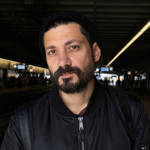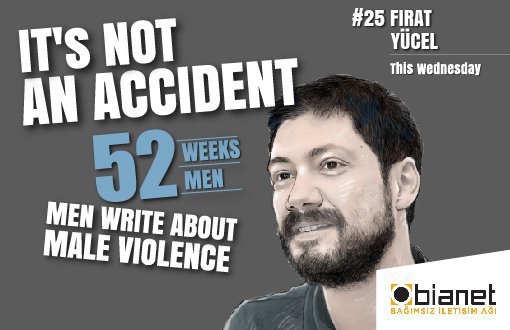*Image from the movie "Get Out"
Click to read the article in Turkish / Kurdish
|
One often talks about the proximity of the movie-watching experience at the cinema and of course the horror cinema with the experience of dreaming. Let's start with a description of a dream. Theodor W. Adorno wrote the following in his dream notes in December of 1964: "The world was about to end. (...) Everyone stared at the sky. Still half-dreaming, I asked whether the world would really come to an end now. People confirmed that it was so, talking just as people talk who are technically in the know; they were all experts. In the sky three huge, menacing stars could be seen; they formed an isosceles triangle. They were due to collide with the earth shortly after 11 a.m.. Then a loudspeaker announced that at 8.20 a.m. Werner Heisenberg would speak once again."
You can listen to the first episode (Family) of the "In Good Times and Bad: Living Together" podcast (in Turkish) here: Spotify, ApplePodcast, Youtube
Adorno's dream
Some dreaming experiences gave Adorno the idea that an individual experiences their own death as a cosmic catastrophe. He says that this is the origin of his interest in dreams. His dream that I quoted above (among all his other dreams where he dreamt of being executed, being beheaded, having cancer, Hitler being still alive, etc.) is one of those that stand closest to this idea of "cosmic catastrophe."
Besides its "cosmic" nature, what is really interesting in this dream is that if we were to speak of something about horror, this is not quite related to "the world coming to an end." As if, what is really horrifying in the dream is not the end of the world, but it is that that same expert, the physicist Werner Heisenberg will be speaking at such an important event as the end of the world. Yes, at 8.20 a.m. Heisenberg will speak. His description of the dream continues as follows:
"I thought that that couldn't be him acting as commentator on the end of the world. It could only be the repetition of a tape recording that had often been played. I awoke with the feeling that, if the world really were to come to an end, this is how it would happen."
What was essentially horrifying?
What horrified Adorno in his dream was not the end of the world. It was not that he was to end along with the world. It was that the end of the world, such a "special" day as the end of the world was to happen with the commentaries of the Nobel laureate physicist Werner Heisenberg, who undertook Nazis' nuclear energy/weapon project. An end of the world with the commentaries of this quantum physicist who did not protest the regime, thinking that the Nazi government or at least their extravagancies would not last very long, continued his work as he does, undertook the nuclear weapon project (had he been successful, he could have caused the end of the world, there would not be this dream), and who was still on the radio, the television after the war...
What turns the dream into a nightmare?
A middle-of-the-road Nazi collaborator speaks at the end of human existence. What else can turn the dream into a nightmare? Him again? This must be a tape! Unheimlich. Everything is very familiar, (the voice of the same boring figure), but worrisome at the same time (three stars forming an isosceles triangle are approaching the earth). Adorno wakes up and thinks, the end of the world will happen exactly like this. The final will turn out to be this banal despite all our efforts, our writings, our acts, our literature. What scares him, what wakes him up in sweat is maybe this worthlessness/ineffectiveness rather than the end of the world.
Cosmic catastrophe
After reading Adorno's dream, I think the following: Can mainstream movie narratives set to assign a special role to the characters in the center of the story be really scary? Dreams instill horror partly because they deprive the person from the feeling of being at the center of the events. (As it is, information always comes from somewhere, it is said that it would happen like this, that it would happen at this time, etc. You keep drifting in the dark and information keeps flowing much faster than the Twitter wall.) Most of the mainstream horror films present not the horror, but the desire of the individual who considers themself as the center of the world and brags about it, on the screen: They are not ineffective, they have the power to change, even when they are on their own... (They are the hero even when the world is about to end, they will be the "martyr" of a nonexistent future at most...) The modern individual's fear not to have any impact cannot come alive, cannot find a place in the world of a character that has the power to change the course of things. Hence, the individual identifying themself with the character by looking at the screen usually feels comfortable, even when horrified, they are rather horrified by the sound effects, they cannot feel a deep horror, the horror of that all-absorbing, majestic victory of meaninglessness. That kind of horror at the cinema is experienced mostly at the margins of the mainstream or farther from it. While commercial cinema gathers action from disaster scenarios, movies with a much lower budget that make room for extremism are not that concerned about the centrality of the character and the identification of the spectator (yes, it has been so since Hitchcock, since Psycho) can arouse such a big horror that can be referred to as "cosmic catastrophe."
Image of the world's end
I am looking for cinematic images about the end of the world in my mind. There are many dynamic images about the beginning of the end or what happens after the end (that land called post-apocalyptic). Yet it seems that there are not so many horror films that reflect the occurrence of the end. There are many horror films where the world changes, zombies rule, cities are destroyed, nuclear threat, droughtiness, viruses, etc. prepare the end of humanity, and which dwell in some kind of post-apocalypse, flirting with science-fiction. But I come across the image of the end in movies that belong to other genres.
The final scene of Lars von Trier's Melancholia. Justine (Kirsten Dunst) and Claire (Charlotte Gainsbourg) are together with Claire's daughter Leo (Cameron Spurr), holding hands in the greens at a small hill, they are waiting for the planet called Melancholy to hit the Earth, in a manner isolated from the world, the society, everything. First an enormous white covers the screen, then a deep black. It is much more pastoral than Adorno's imagination of the world's end. Is it scary? It is perhaps rather melancholic just like the name of the approaching planet. Since the characters are scorched with their own animosities and are not quite related to the rest of the world, the death of the individual and the end of the world are almost equalized. It is not like this in dreams filled with horror that wake one up in sweat; it is the universe of redundant details, not that of the pastoral green: It is both big as the world and small as the individual. Heisenberg will speak at twenty past eight...
The end of the world is a kind of catastrophe that commercial narrative cinema can only deal through something mixed with comedy maybe. Don't Look Up is a recent example. In this movie, as in Adorno's nightmare, there are plenty of people staring at the sky, each acting as an expert. The last scene is a "last meal." Characters that finished praying, holding hands. Despite the whole absurdness of the movie (or maybe because of it), one can argue that this image of the end is more horrifying than that of Melancholia. Maybe because of the idea that it could have been some other way, we could have stopped it, or maybe because the idea whether everything would be so banal embraces the table despite the whole ritualistic mise-en-scene. But this is a comedy. The mainstream cinema which cannot imagine the end of capitalism is capable of imagining that capitalism will bring the end of the world. After all, a world that is not capitalist is much more horrifying for the mainstream; the image of chaos in movies filled with scattered crowds that are burning and destroying is exactly the expression of this, there will be chaos if the system collapses. Either there will be chaos or capitalism will bring the end of the world, there is no midway.
Being cornered and movement
There is something told by hostage/torture movies (sometimes called "torture porn") in the style of Saw, which Jordan Peele has recently politicized and turned into an assimilation tale in Get Out. The only reason why these movies are directly considered as horror films and why they arouse horror in spectators is not the torture equipment or the sudden sound effects (Apichatpong Weerasethakul is all ears, listening to these effects at length in Memoria, this movie is actually a marginal horror movie in a sense). Movies about being cornered in Saw style imprison the character's and the spectator's look along with the character to a single place at one point in the story (sometimes at the beginning, sometimes towards the end). This condition of being cornered is a parenthesis where the man who has the effective look in the patriarchal cinema (Laura Mulvey was saying that the movie spectator identifies with this male look and plays the role of the voyeur in "the surreptitious observation of the unknowing and unwilling victim") is deprived of the license to look for a while. The spectator who sits in their seat at the movie theater or at home, and has been swimming in the look pool offered by the movie, suddenly loses the capability of looking together with the character when the character is imprisoned. The character is closed in a room, hands are tied, and just like the spectator images appear before them.
In Get Out, the character is strapped to a chair. Before his eyes are an old-style tube-television screen and a deer head hanging on the wall. A ping-pong table behind him, end tables carrying lamps around him. Art direction of the white supremacy. Such a condition of being subjugated is indeed much closer to the feelings expressed by Adorno in his nightmare. Whether everything would end in such a silly way, whether it would all end in the mise-en-scene of this bourgeois rural family, the remainder of the aristocracy, who made a decoration of a deer head... Horror is in a state of impotence against this banality imposing itself as dominant. Maybe it is not the end of the world, but it is the end of the person. Yet not an arbitrary person. Get Out too attributes a uniqueness to its character: The property of being the first person that gets away from and defeats this family that colonizes the bodies of the black people. For Get Out is not completely a horror film either, it is a horror-comedy.
Political horror
When you search for "political horror," the series The Purge, a series that has been continuing since 2013, will immediately appear on your screen... The most interesting aspect of the movies in this series is their continuous need for television news in order to ensure the flow of the story. Purge night has started, lock yourself in the house, Purge is over, you can leave your house, an attack against the U.S. army, Mexico and Canada opened their borders. It is the opposite of the movies where the character's looks are restricted to the images flowing on a single television; a screen everywhere, last-minute news everywhere, hardly found radio frequencies... Is this why The Purge films are more like action movies rather than horror films even though they include so much quarantine, shutdown, confinement, murder, etc.? Does horror cinema demand the look to be somehow subjugated? Does a story world where television screens convey news to everybody in every corner, with or without intention, invite a visual regime where there is action, as befits the name a capability to move? (In The Purge Forever, the characters are endowed with such a capability to move despite all lockdowns, Neonazis of post-Trump age who hunt people in the streets, etc. that the white American farm owners who we initially think of as racist desperately cross the Mexican border at the end, their babies are born there...)
What is in fact a horror film?
What is really a horror film? Monsters, zombies, demons, vampires, all kinds of bodily mutation (body horror)... Movies including these obviously count as horror films regardless of whether there is being subjugated or not. As in The Purge, in the movies reflecting the fears of the U.S. concerning its own survival, unity, etc. (whether we are ceasing to be a melting pot, whether we are drifting towards chaos, "anarchy"...), such creatures are not present as such, but are present through gestures and costumes. For example, let's think of the abandoned movie theater with bat corpses hanging down its ceiling, showing a vampire movie on the screen, in The Purge Forever. The figures resting against the foyer's walls, suddenly coming alive and attacking the main characters are not actually zombies or such; they are a group of "purifiers" acting like zombies. In the absence of deformation or turning into a monster, horror cinema makes use of its own ghosts. Vampire movie on the screen, zombie imitators on the wall.
Naming the fear
Robin Wood described the basic formula of horror films in his book titled Hollywood from Vietnam to Reagan... and Beyond first published in 1986 as follows: "Normality (i.e., 'accordance with the dominant societal norms') is threatened by the monster."
Wood starts his book's section titled "The American Nightmare: Horror in the 70s" with a long prologue where he brings together Marx' estranged labor theory and the unconscious/repression theories of psychoanalysis. I do not know if he is the first one to mention, but the most commonly mentioned description of horror cinema appears as a subtitle in these pages: Return of the Repressed. According to Wood, American horror cinema of 70s calls back all that is repressed under the patriarchal capitalism (bisexuality, homosexuality, proletariat, and every kind of identity seen as "other" by the American consciousness - woman as the other of male dominance, different ethnical identities, different ideologies starting with communism, etc.) in various forms. According to Wood, precisely because they are not well-organized, thought-through societal criticisms and more importantly they are popular products aiming to shock, to provoke, and to scare the spectator directly, horror films can come into a more unfiltered contact to what is swept under the rug. Yet, this is not a model that for example overlaps the slaughterhouse workers of The Texas Chain Saw Massacre (1974) directly with the proletariat either. Wood does not actually claim that horror films are concerned with representing those excluded by the acceptable or the norm with a conscious strategy. He rather talks about some sort of unconscious garbage (in a good sense). He describes a genre that can make use of reduction, simplification, making it blindingly obvious, provocation, and that cannot in fact exist without such things (right by the rule that "horror films must scare'').
It has been a long time since this definition of horror cinema by Wood. There is no doubt that currently horror images are produced more under self-consciousness. Horror cinema itself is somewhat like the scene of The Purge Forever's movie theater; it produces horror by using its own nostalgia. I am not trying to reach a reading on Jameson's "domination of nostalgia" or Baudrillard's "copy of a copy" because I think that extremely concrete societal tension lines underlie these interplays within genre, pastiche, and nostalgia. Additionally, I think that Wood's fundamental argument is also supported by several examples of horror genre that make a more conscious contact with the decolonialist, feminist, queer, post-human strategies since 70s, ranging from Roger Corman's zombies to Mati Diop's Atlantiques' zombies, from Cronenberg films to Titane: Power of establishing a closer relation to the political - freed from the concerns specific to the "art" cinema like refinement or grace, usually freed from high-budget commercial cinema's concerns related to "production quality." Horror cinema - usually in contact with other genres - still preserves this power. This is the case not only because of this cinema's effect on the films of Jordan Peele, Bong Joon-ho, Julia Ducournau, Mati Diop and such, but also for the following reasons: the geographical width of the Folk Horror anthology (shown in 41st İstanbul Film Festival) prepared by Cüneyt Çakırlar, which gave a folder to the journal Altyazı, the power of these horror narratives to go beyond colonialist theses - maybe even to imagine the era before colonialism - and finally the strange relationship of the horror genre with the so-called "archive" and essay genre.
Does the unrepressed come "back" too?
Let me still leave a doubt in concluding on these digital pages and related podcast series. The return of the victims of a crime committed in the past (ghosts), an arm rising from the underground, the blood squirting out of cracks... Isn't there a note that transfers the crime to the past, disregards today, the present, and the crimes of the present in this paradigm of the Return of the Repressed? Another dimension that misses out the continuity of colonialism, capitalist class domination, male domination, and racism, or relies too much on the metaphors that relate these mostly to the past? On the other, as frequently said, decolonization is not a metaphor. The extreme right does not actually represent extremism at all; it represents the continuity of the right. Liberal ideology which monopolizes "human nature" by considering it competitive, opportunist, etc., paints also what is cultural into its own color, and commands us to fear the collective (from Joker to Matrix Resurrections, from Us to Belfast, aren't crowds viewed as objects of horror? How many films can we think of which distance themselves from this chaos imagination when considering crowds, which find not only horror, but also hope in crowds? How many horror films?) Zombies live among us, for sure. If the horror genre has a certain immunity against censorship as Wood and several others suggest, can we imagine a horror film narrating the attackers of Aysel Tuğluk's mother's grave, a horror film taking place in the horror climate of AKP Turkey? A horror cinema that narrates not the return of a crime that was covered up, but its domination over today, that is surprised saying the world is ending, the same commentator again, that is surprised by the present, shocked by the present?
About the projectThe podcast and article series "In Good Times and Bad: Living Together" are prepared as part of a project run by the Hafıza Merkezi Berlin (HMB) and IPS Communication Foundation / bianet. The coordinators of the project are Özlem Kaya from the HMB and Öznur Subaşı from the IPS Communication Foundation. The project advisor is Özgür Sevgi Göral and the project editor is Müge Karahan. With a focus on "living together", the series will address the themes of family, punishment, fear, hate, creativity, racism, memory, lie, anthropocene and friendship. The episodes will be published every 15 days on Tuesday. |
(SO/NÖ/VK)





.jpg)


